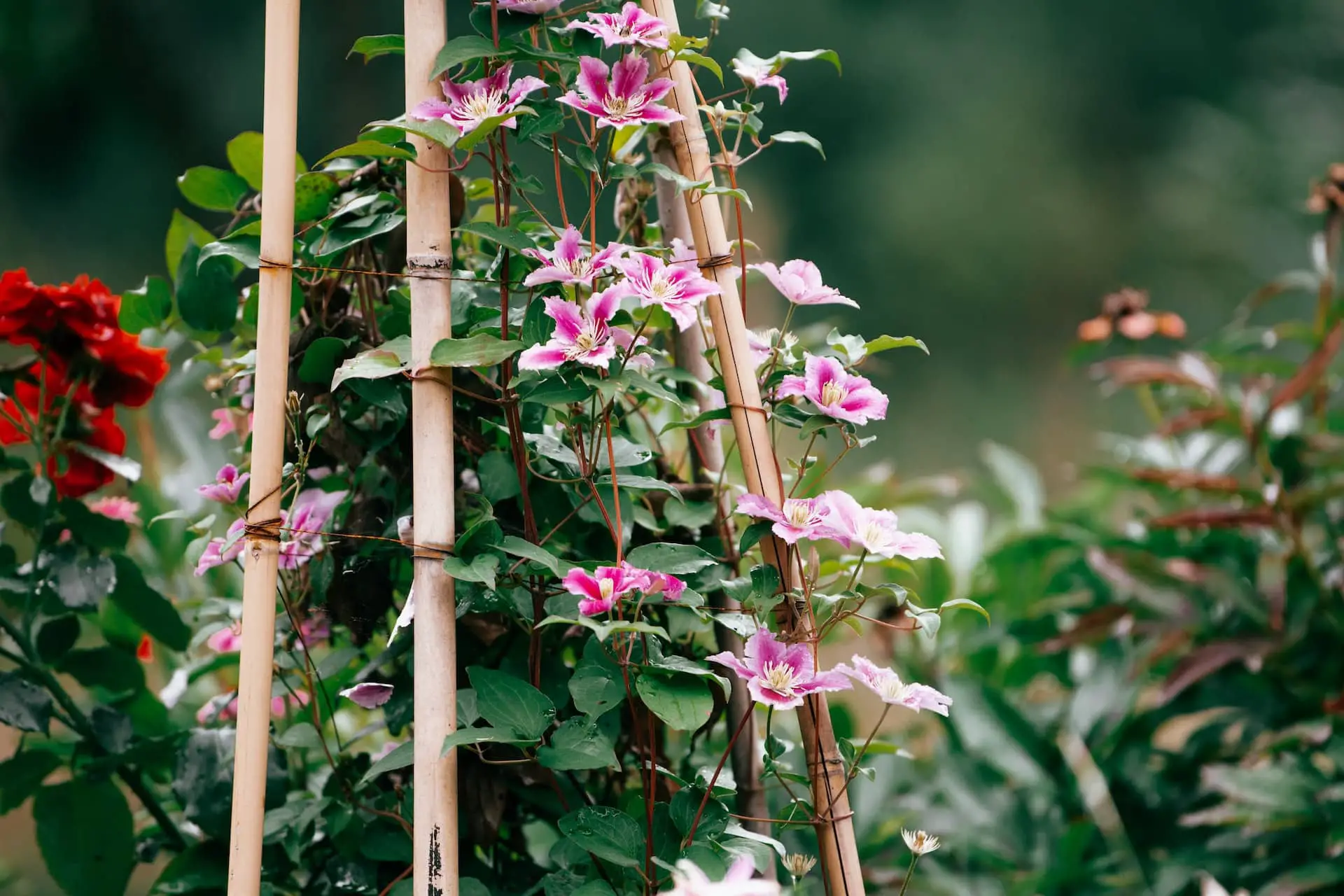Clematis are climbing vines that grow the best if they can climb upon different objects. In nature, Clematis tend to climb up on anything from rocks to trees, and if they don’t find anything nearby to climb upon then they will crawl on the ground until they find something.
To train clematis use chicken wire, start by wrapping the chicken wire around the designated area. Use a couple of nails or hooks to secure the top section of the wire, preventing it from sliding down. Once the chicken wire is in place, you can begin tying your clematis branches onto it. Use twine, gardening wire, or a similar material to secure the branches to the chicken wire, similar to how you would attach them to a trellis. This will provide the necessary support for the clematis to climb and thrive.
If you don’t have a lot of space on which the Clematis should climb up, then my personal recommendation is to use a Tower Obelisk Click here to check it out on Amazon.com
A well trained Clematis will look amazing in the garden or pots, but you will have to start training it as early as possible. Mature Clematis that have woody stems can be still trained, but you will have to give them a good pruning. All varieties of Clematis can be trained, but you will have a lot easier time training Group 2 and Group 3 Clematis as these ones will flower on new wood.
This way you can actually strategies where the Clematis flowers will grow, which will make it easier to imagine how they will look in a couple of years. If you want to know how to prune your Clematis then check out my recent article Pruning Clematis ( When & How ).
How To Train Clematis
Training clematis is a key step in ensuring its proper growth and support. Begin by installing a sturdy trellis, arbor, or other support structure near the planting site. As the clematis grows, gently guide the stems towards the support system, using soft twine or plant ties to secure them without causing damage. Aim to evenly distribute the stems and encourage them to climb and intertwine with the support. Avoid pulling or forcing the stems too tightly, as this can lead to breakage. Additionally, regularly monitor the growth of the clematis and adjust the training as needed to maintain an even and balanced appearance.
Earn a 50% Commission on each sale by simply sharing my guides with friends and family on social media, check out Flower Duty Affiliates
How To Train Clematis Up A Trellis
Trellises are excellent for training Clematis, as these structures are specially made for climbing plants. There are a lot of different types of trellises on the market, and you should choose one that you actually like. Make sure to place the trellis in a full sun location, as Clematis need full sun in order to grow big and healthy. Plant the Clematis 8 inches away from one of the legs of the trellis.
It is important to keep some space between the trellis and the Clematis, cuz you never know when you will want to remove the trellis, and this way you won’t harm the Clematis. From here on you can wrap the Clematis around the trellis or use twines or plant clips to secure them. When using twines or plant clips, make sure to allow space for the Clematis stems to actually grow, if you secure them so firm that they can not grow then these stems will die off. If your Clematis is not growing then check out my recent article Clematis Not Growing ( Top 6 Reasons ).
How To Train Clematis Up A Fence
Fences can be an excellent place for the Clematis to climb, and once these plants fill out the fence, the blooms will be mesmerizing. Clematis can be trained to climb up any type of fence, although you will have to use your imagination. If you have a rather small Clematis, then you will have to place a wire vertically from the Clematis to the fence. After which you should place a couple of wires horizontally, around 15-20 inches apart.
By doing it this way, the Clematis will slowly climb up the vertical wire, and then start to spread out on the horizontal wires. Twines and plant clips should be used to hold the Clematis stems secure, although you can simply twist the stems around the wires. Just keep in mind that if you twist the stems around the vines, it will be somewhat hard to prune the Clematis. If you have a brick wall then you will have to do some drilling, place a couple of hooks and use these as anchor points for the wire. If the Clematis buds are not opening then check out my recent article Clematis Buds Not Opening ( Top 5 Reasons & Fixes ).
How To Train Clematis Up A Post
Clematis that are growing up a post, and fill the post with flowers look amazing. Although it can be somewhat of a challenge to train the Clematis to grow up a post. If you want the Clematis to climb up a wooden post, then you can use a couple of nails and some wire to create a frame upon which the plant can climb up. Concrete posts are a little bit more challenging, although with some imagination it is still doable.
To get the Clematis to climb upon a concrete or metal post, wrap around them chicken wire or a wire mesh, metal or plastic, it doesn’t really matter as long as they are sturdy enough. You can use the chicken wire or the wire mesh and twist the Clematis stems between the gaps, or you can use twines or plant clips to hold the stems steady.
How To Train Clematis Up A Pergola
Clematis can be trained to climb up pergolas but it will take some time until they do so. If you want your Clematis to climb on the top of the pergola then it can take anywhere from 3-6 years until the Clematis is big enough to fill the top of the pergola, but it is well worth the wait. The main challenge with training the Clematis up a pergola is that the plant needs to grow a fair bit until it reaches the top of the pergola.
Choose one of the legs of the pergola where you want the Clematis to climb up, and make sure that this location gets plenty of direct sun. You can use a wire placed vertically to train the Clematis to the top of the pergola. Or if you want it to also fill out the space where it climbs up, then use either a zig-zag pattern with wire or chicken wire. This way the Clematis will not grow straight to the top of the pergola, instead, it will fill out the space on the leg of the pergola first and then it will grow towards the top of it.
It can look fairly ugly if you only train the Clematis to climb up vertically because once it will reach the top of the pergola, you will see very few leaves on the vertical part and usually no flowers
How To Train Clematis Up A Wall
A wall covered with Clematis is something that neither you nor your guests will ever forget. The bigger the wall is the more opportunities you have to make an amazing design with the Clematis, especially if you use different types of Clematis that bloom at the same time. To train the Clematis up a wall, you will have to drill some holes and place a couple of hooks. These metal hooks will be where you stretch out the wire, on which the Clematis will climb.
You will have to use a vertical wire from the base of the Clematis to the wall, this is where the Clematis will start climbing up on the wall, and from there it will spread out. From there on you will have to place a couple of horizontal wires, which the Clematis can use to fill out the area. Use plant clips to anchor the Clematis stems to the wire, this way you train them to grow in a certain direction.
You can even place a couple of horizontal wires at an angle if you want your Clematis to look like an art piece. The only thing that you need to keep in mind, is that Clematis will newer climb towards the ground, they either climb up or horizontally.
How To Train Clematis Up An Obelisk
Obelisks are usually used to train potted Clematis, and they tend to be filled by the plant rather fast. Some people use the structure of the Oblesik to hold in place the Clematis stems, and it does look really good. The problem with this approach is that if you want to replace or repaint the obelisk, you will have to chop back most of the Clematis in order to be able to remove it.
In this case, you should use plant clips to secure the Clematis stems, and train them to grow around the Obelisk. You can even grow different varieties of Clematis in the same pot, and train them to climb up the Obelisk, although pruning might become a challenge.
How To Train Clematis Up A Tree
Clematis will climb up on trees, but they tend to need a little bit of help. If you want your Clematis to climb up a tree then you will have to use string and not metal wires, as these will damage the tree. Avoid using nails, because a healthy tree will sooner or later push the nails out. Get a piece of string and tie it around the tree or branch where you want the Clematis to climb up.
After this, you can use smaller pieces of string that you will tie to the main string that is already around the tree. By doing it this way, you will not damage the tree and it will be fairly easy to train the Clematis.
Key Takeaways
- To train a Clematis make sure that it has something to climb up on, like a trellis, fence, an obelisk, and so on. Plant the Clematis in a full sun location around 8-10 inches away from the object on which you want it to climb. Use twines or plant clips to secure the Clematis stems to the object, and as it grows just guide it where it should grow.
- No matter where you want your Clematis to climb up you have to make sure that you plant it in a full sun location.
- As the Clematis continues to grow, make sure to add new plant clips and direct the stems where the Clematis can actually grow.

